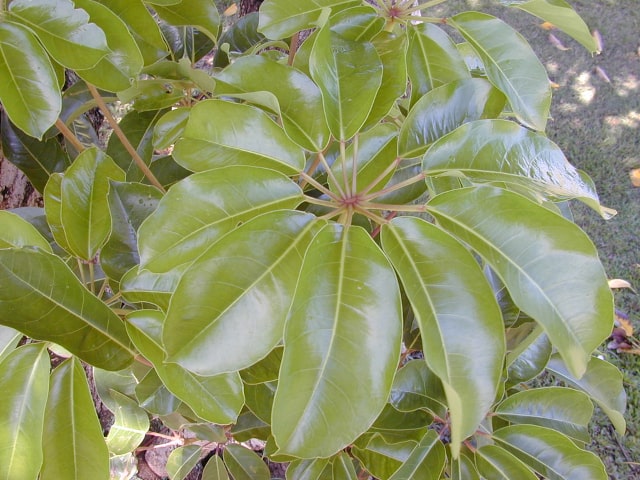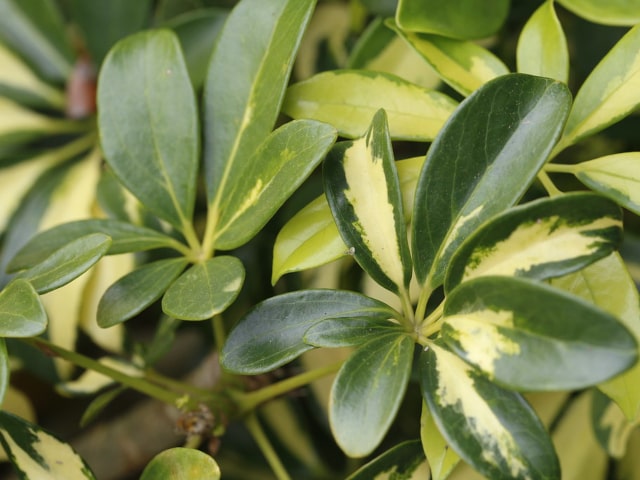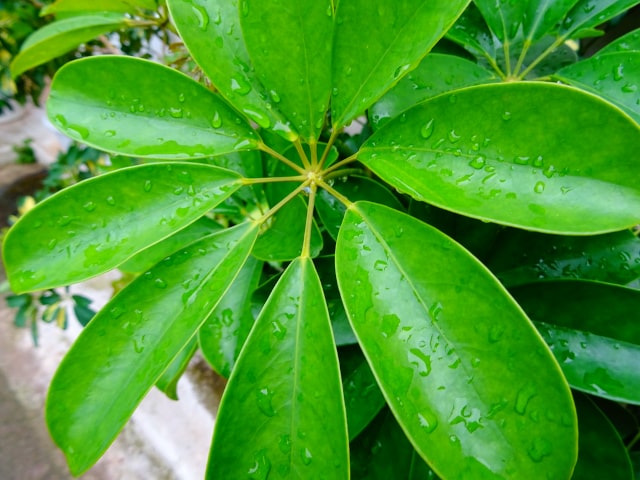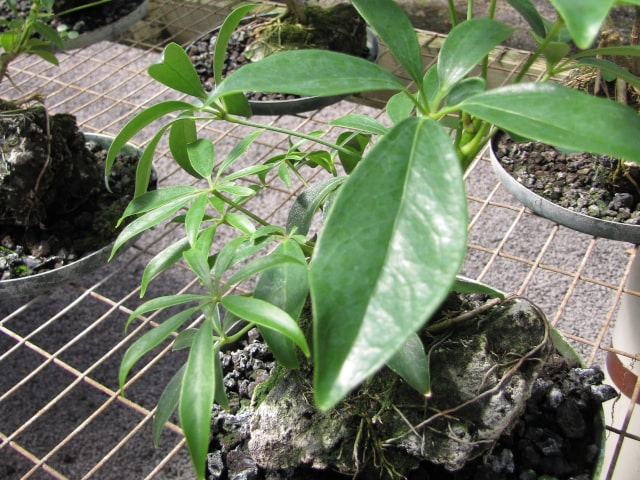
Umbrella trees are many people's favorite houseplants. They are relatively easy to grow so you can make your umbrella plant thrive without much trouble. Even beginners can enjoy these gorgeous plants to the fullest. However, as a beginner, you need to understand that umbrella plants need pruning. This is not so much of a problem, though, so it's possible to say that umbrella plants are easy to care for.
These are large plants that typically grow to the height of about 6 feet indoors. They are known for their unusual, 8 spoke style foliage that looks like an umbrella (hence the name). If you wish to grow this plant in your home you need to know that it doesn't bloom indoors but there are many gorgeous varieties with splendid leaf markings that look amazing indoors.
It is not difficult to care for the umbrella plants so even beginners can do it. However, it is important to follow the care instructions carefully in order to prevent injuries to your plant and to ensure that your umbrella tree grows strong and healthy.
The first thing you need to understand about umbrella plants is that they are very fast growers. They can grow very tall in just one growing season. This is ideal for those who want their houseplants to be large and attractive. However, this is something you need to keep in mind because you need to provide your plant with enough space to grow.
Growing Conditions
There are some essential growing conditions that you need to provide to your umbrella plant to make it thrive:
- Soil. Umbrella trees thrive in peat moss-based potting mixes. The best choice is a mix that is 2 parts peat moss and 1 part perlite.
- Light. This plant will thrive under bright but indirect light. It is best not to subject it to any direct sunlight. However, even a bit lower lighting conditions will not harm your umbrella tree. They will simply slow its growth but it will not seriously harm it. As noted above, you should not subject your umbrella plant to direct sunlight. A few hours per day maximum is tolerable, but not more than that. Too much light may make the leaves burn. Sometimes, the light is not equally good from all the directions. You will notice this if the plant grows more on one side than the other. If this happens, make sure to turn the container to the other side so it receives more sunlight.
- Temperature. Your umbrella plant will thrive on the average room temperature between 60 and 75 degrees F (15 to 24 degrees Celsius). However, make sure to never grow this plant in a room that has a temperature lower than 55 degrees F (13 degrees Celsius) or higher than 75 degrees F (24 degrees Celsius). It is also important to avoid any cold drafts and sudden temperature drops.
- Watering. It is very important not to over-water your umbrella tree. It is best to only water once the top of the soil becomes dry. Lack of water tends to be less of an issue than over-watering. Over-watering can make the plant's leaves to turn yellow. Under-watering, on the other hand, may cause leaves to drop. To provide the proper amount of water and avoid over-watering it is best to wait until the top of the soil is dry before you water your plant again.
- Fertilizer. It is important not to over-feed your plant. It will just cause problems. If you want to feed your umbrella tree from time to time, give it a diluted fertilizer once per month from spring to fall. It is also important to remember that you should fertilize even less often once your umbrella plant reaches the size you want it to be. If you keep feeding it often, it will grow more. Fertilizing an adult umbrella plant several times per year is ok, as long as the plant has reached the size you want it to be.
- Humidity. Umbrella trees need average humidity levels inside the homes. In case the air is too dry in the room it might cause some problems so make sure to increase humidity levels in the room where you keep your umbrella plant. If the air in your home is extremely dry it is best to mist the leaves of your umbrella plant from time to time. This will provide your plant with a bit of humidity it needs. Also, this is a good way to make sure that the dust doesn't accumulate on the leaves of the plant. Raising the humidity levels can also prevent pests from attacking your umbrella plant, so this is another thing to think about.
Repotting
Since umbrella plants are fast growers it means that they can occasionally outgrow their container. It typically happens only after the umbrella plant reaches maturity. Once it is mature it will need to be repotted every 2 to 3 years. Keep this in mind if you wish to grow an umbrella plant in your home.
You will know that it's time to repot your plant once you notice that the roots are growing through the drainage holes in the pot. This is when you should move your plant to a larger container. Make sure to always choose a relatively large and sturdy pot because umbrella plants can be very top heavy. Also, if you want to repot your plant make sure to do that only during the spring.
Pruning
Umbrella plants are known as fast growers. It is therefore not surprising if you end up with a plant that is too tall, too bushy or growing in all directions. This is not an optimal situation and not just because of the aesthetics. If any of these things happen you will need to prune your umbrella plant. This is the only way to keep your pant in the size and shape you want.
One great thing about umbrella plants is that they recover very quickly from pruning. It means that even if you over-prune it will not harm your plant. It will simply grow fuller in the next spring. Actually, pruning is a great way to make your umbrella plant lush again. If you notice your plant becoming sluggish you may prune it to rejuvenate it and make it strong and healthy again.
Propagation
Umbrella plants are not easy to propagate. However, nothing forbids you from trying. These plants can be propagated using cuttings from a mature plant. If you want to use cuttings, make sure that they are healthy and at least 2 inches long.
Once you place cuttings in the soil, make sure that the tip of the cutting that is growing is not under the surface of the soil.
Also, keep in mind that umbrella plants can sometimes be grown from the seed. This might be a good alternative method if you have a problem with cuttings (if they don't want to take root) and if you find it impossible to propagate using cuttings.
Diseases
Umbrella plants tend to be easy to grow indoors but they are susceptible to certain issues. One of the most common problems are leaves turning yellow or the plant losing leaves. Keep in mind that this plant will naturally lose its lower leaves in order to encourage the new growth. In other words, this might not be a problem at all.
However, if you notice your plant losing a lot of the upper leaves, it can mean that you are doing something wrong. Over-watering is the most common mistake you can make with these plants. If this is not the issue then it might actually be under-watering, too much heat, lack of light, sudden changes in temperature or something else.
In order to identify the source of the problem it is important to go through the process of elimination. Go through all car instructions to see what you might be doing wrong.
Another problem, though less common, is to have the leaves and stems turning brown. The likely cause of this issue is over-watering in case the leaves and stems are soft. If this happens, it is important to check to roots of your plant to see if there is any root rot. If yes, it is important to act quickly. You will need to remove all affected leaves, stalks and root sections. After you remove them make sure to repot your plant. This is the only way to save your umbrella plant from dying.
Another thing to remember is that your umbrella plant can develop fungal leaf spots. This might be another reason for the brown spots on the leaves. The infected leaves will eventually drop and the disease will spread. To prevent this problem make sure to remove all of the infected leaves and other parts of the plant before the disease has a chance to spread.
Your umbrella plant can also develop bacterial leaf spots. They will look like yellow spots on the leaves but these will not be caused by the over-watering. Yellow spots on the leaves may mean a bacterial disease. It is important to remove all of the affected leaves as soon as they appear in order to prevent the disease from spreading.
Pests
A common threat to umbrella plants are spider mites. They are more common in dry air conditions. It is very important to inspect your umbrella plant regularly to see if there are any signs of pests. The most common sign is spider webbing under leaves. In case you notice this, you need to take immediate action to get rid of pests from your umbrella tree.
Generally speaking, umbrella plants don't have many pests, which is one of the best things about these plants. However, it doesn't mean that you should never inspect your plant. On the contrary: it is highly advisable to check the leaves, stems and other parts of the plant regularly. This is the only way to notice the pest problem right when it's developing and to treat it before it becomes too serious. Any pest infestation can be treated successfully if you notice it on time. This is the best way to make your umbrella plant recover quickly and to become strong and healthy again.
Photo credit: Forest and Kim Starr




0 Comments